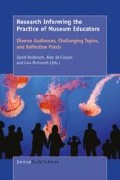Abstract
The roles of museums and galleries in educating children and youth are growing as these institutions supplement the learning occurring in schools. The youth art apprenticeship movement seeks to engage youth in art education, career skills development, and more (Charland, 2005). While the majority of art education research has focused on mapping the history of the field and integrating art education concepts into curriculum creation, the effects of the resulting learning experiences on students begs for further examination.
Access this chapter
Tax calculation will be finalised at checkout
Purchases are for personal use only
Preview
Unable to display preview. Download preview PDF.
References
Ackerman, E. (2001). Piaget’s constructivism, Papert’s constructionism: What’s the difference? Retrieved from http://learning.media.mit.edu/content/publications/EA.Piaget%20_%20Papert.pdf
Ajjawi, R., & Higgs, J. (2007). Using hermeneutic phenomenology to investigate how experienced practitioners learn to communicate clinical reasoning. The Qualitative Report, 12(4), 612–638.
Andrews, K., & Asia, C. (1979). Teenagers’ attitudes about art museums. Curator, 22(3), 224–232.
Anfara, V. A., Brown, K. M., & Mangione, T. L. (2002). Qualitative analysis on stage: Making the research process more public. Educational Researcher, 31, 28–38.
Bryman, A., Teevan, J. J., & Bell, E. (2009). Social research methods (2nd ed.). Don Mills, ON: Oxford University Press.
Burgess, L., & Addison, N. (2007). Conditions for learning: Partnerships for engaging secondary pupils with contemporary art. International Journal of Art & Design Education, 26(2), 185–198.
Charland, W. (2005). The youth arts apprenticeship movement: A new twist on an historical practice. Art Education, 58(5), 39–47
Chin, C. (2011). Vibrate…resonate…. Art Education, 64(3), 41–45.
Crawford, M. B. (2009). Shopcraft as soulcraft. New York, NY: The Penguin Press.
Halpern, R. (2009). The means to grow up: Reinventing apprenticeship as a developmental support in adolescence. New York, NY: Routledge.
Hamilton, S. F. (1990). Apprenticeship for adulthood: Preparing youth for the future. New York, NY: The Free Press.
Herne, S. (2006). Communities of practice in art and design and museum and gallery education. Pedagogy, Culture & Society, 14(1), 1–17.
Hickman, R. (2010). Why we make art and why it is taught (2nd ed.). Bristol, UK: Intellect.
Innella, V. (2010). Curriculum and the gallery space: A service-learning partnership. Art Education, 63(3), 46–52.
Irwin, R. L., & Kindler, A. M. (1999). Beyond the school: Community and institutional partnerships in art education. Reston, VA: The National Art Education Institution.
Lemerise, T. (1995). The role and place of adolescents in museums: Yesterday and today. Museum Management and Curatorship, 14(4), 393–408.
Mason, D. D. M., & McCarthy, C. (2006). The feeling of exclusion: Young people’s perceptions of art galleries. Museum Management and Curatorship, 21(1), 20–31.
Schofield, K. (2003). Temporary residencies: Student interventions in the gallery. In N. Addison & L. Burgess (Eds.), Issues in art and design teaching (pp. 144–150). London, UK: RoutledgeFalmer.
Serido, J., Borden, L. M., & Perkins, D. F. (2011). Moving beyond youth voice. Youth & Society, 43(1), 44–63.
Tellis, W. (1997). Introduction to case study. The Qualitative Report, 3(2). Retrieved from http://www.nova.edu/ssss/QR/QR3-2/tellis1.html
Tuan, Y.-F. (1975). Place: An experiential perspective. The Geographical Review, 65(2), 151–165.
Van Moer, E., De Mette, T., & Elias, W. (2008). From obstacle to growth Dewey’s legacy of experiencebased art education. International Journal of Art & Design Education, 27(1), 43–52.
Wenger, E. (2009). Communities of practice: A brief introduction. Retrieved from http://neillthew.typepad.com/files/communities-of-practice.pdf
Witmer, S., & Borst, J. (1999). Making connections: Getting teens to talk about art. What is taught? What is learned? How do we know? Art Education, 52(5), 33–38.
Yin, R. (2009). Case study research: Design methods (4th ed.). Thousand Oaks, CA: Sage Inc.
Author information
Authors and Affiliations
Editor information
Editors and Affiliations
Rights and permissions
Copyright information
© 2015 Sense Publishers
About this chapter
Cite this chapter
Fuchs, T. (2015). Ecologies of Youth Art Apprenticeship. In: Anderson, D., Cosson, A.d., McIntosh, L. (eds) Research Informing the Practice of Museum Educators. SensePublishers, Rotterdam. https://doi.org/10.1007/978-94-6300-238-7_16
Download citation
DOI: https://doi.org/10.1007/978-94-6300-238-7_16
Publisher Name: SensePublishers, Rotterdam
Online ISBN: 978-94-6300-238-7
eBook Packages: Humanities, Social Sciences and LawEducation (R0)

